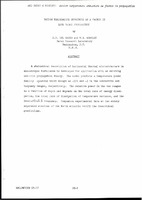| dc.contributor.author | Del Balzo, Donald R. | |
| dc.contributor.author | Moseley, W. B. | |
| dc.date.accessioned | 2018-10-11T14:04:39Z | |
| dc.date.available | 2018-10-11T14:04:39Z | |
| dc.date.issued | 1975/10 | |
| dc.identifier | 328 | |
| dc.identifier.govdoc | CP-17/6 | |
| dc.identifier.uri | http://hdl.handle.net/20.500.12489/12 | |
| dc.description.abstract | A statistical description of horizontal thermal microstructure in anosotropic turbulence is developed for application with an existing acoustic propagation theory. The model predicts a temperature power density spectrum which decays as -5/3 and -3 in the convective and buoyancy ranges, respectively. The relative power in the two ranges is a function of depth and depends on the total rate of energy dissipation, the total rate of dissipation of temperature variance, and the Brunt-Vaisala frequency. Companion experimental data at two widely separated stations of the North Atlantic verify the theoretical predictions. | |
| dc.format | 10 p. : ill. ; digital, PDF file | |
| dc.language | English | |
| dc.publisher | NATO. SACLANTCEN | |
| dc.source | In: Ocean Acoustic Modelling (SACLANTCEN Conference Proceedings CP-17), Part 6, 1975, pp. 30-1 - 30-10. | |
| dc.subject | Acoustic propagation | |
| dc.subject | Seawater thermal properties | |
| dc.subject | Ocean acoustics | |
| dc.subject | Acoustic models | |
| dc.title | Random temperature structure as a factor in long-range propagation | |
| dc.type | Papers and Articles | |
| dc.type | Conference Proceedings (CP) | |
